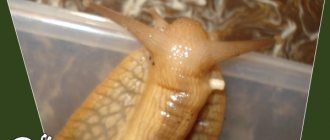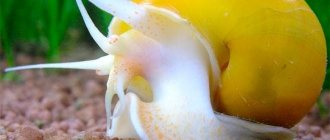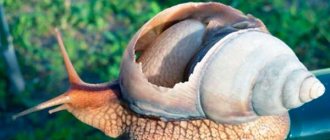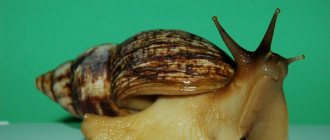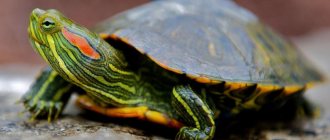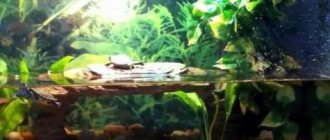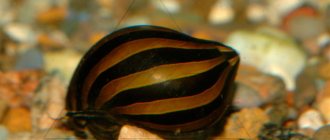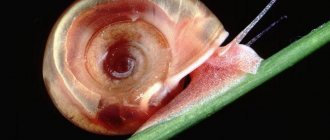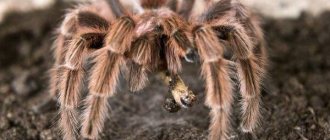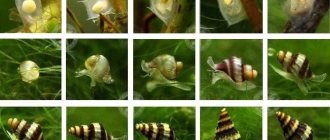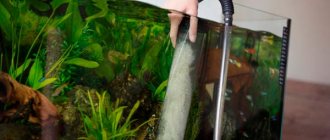How to build a terrarium for “Akhatinki” yourself
These mollusks like a subtropical, temperate climate, and even a slight drop in temperature can cause their death. Therefore, owners must provide their pets with suitable conditions. In addition, Achatina requires a special tank - a terrarium, in which it is necessary to reproduce with maximum accuracy the environment familiar to these animals.
Many owners of Achatina use a regular aquarium; in it you can create an excellent imitation of natural conditions. In such a tank, the snail will be protected from drafts and cold air, it will remain at room temperature and it will be easy to maintain suitable humidity. The owner should be wary if his ward has become inactive - in this case, there is a risk of death of the Achatina, and most often this happens due to the inattentive attitude of the owner.
An ideal terrarium for Achatina snails
Many factors are important - from the size of the tank to its decor - after all, we are not talking about ordinary, but about exotic mollusks:
- When calculating the volume of the tank, it should be taken into account that one clam requires at least 10 liters. It is worth immediately taking into account that, although in captivity Achatina does not grow to the same gigantic size as in the natural environment, they are still quite large snails;
- for a 30-liter container, a couple of Achatina are enough - however, if they live in comfort, then you won’t have to wait long for the appearance of offspring;
- such a pet will not run away, but it may well crawl out of the tank, so it is advisable to provide it with a lid with holes - this will provide both protection and ventilation;
- the ideal size of a house for snails is a height of at least 20 cm, a width of 35 cm;
- direct sunlight is harmful to Achatina, they can lead to the death of the pet, so the terrarium should be installed in a dark place;
- in a terrarium or aquarium, the bottom should be covered with a layer of soil - moss and coconut substrate are ideal for snails;
- Achatina should have several feeders - everyday food is placed in one, additional feeding is placed in the others: a grain mixture, a composition with eggshells, feed chalk, rolled oats, etc.;
- There must be a container for swimming - made of plastic material, with low sides and a small volume of water so that the snail does not choke (it will not splash or dive, it just enjoys being in the water);
- all tanks, bowls, etc. should be secured, otherwise the snail may turn everything over with an awkward movement;
- in order to maintain and monitor readings of temperature, humidity and other parameters, the container must be equipped with a thermometer, hydrometer and other instruments;
- The terrarium requires weekly general cleaning; to maintain constant cleanliness, you can prepare a sponge with good absorbent properties.
Special attention should be paid to the soil, as it performs several important functions at once:
- maintains humidity in the tank - to do this, it is enough to spray it 2-3 times during the day;
- many Achatina prefer to rest during the day, buried in the soil - therefore its layer should be thick enough and the consistency should be loose;
- the substrate is also a place for laying eggs - it makes the future offspring cozy and warm;
- the soil eliminates cases of injury to snails when they slide off the walls or lid of the tank and fall to the bottom (it often happens that when falling from a height, Achatina’s shell breaks and the animal dies).
Basic principles for choosing a terrarium for snails
There are several principles by following which you can purchase a practical, environmentally friendly and comfortable home for Achatina.
- Selecting containers from non-toxic materials - glass, plexiglass, food-grade plastic, plexiglass.
- Choice of form. Round houses are not recommended. Better is a rectangular option with transparent or translucent walls.
- Volume of the ulitaria. It depends on the size of the Achatina shell. For every centimeter of shell, ideally there is a liter of space. Adults grow up to 11-15 cm. Accordingly, you will need a volume of 10 to 15 liters. If you plan to keep several individuals in one place, you can reduce the optimal volume by a third. It is important to understand that the more spacious the terrarium, the higher the chance of growing Achatina of enormous size.
- Age accounting. If containers for small Achatina snails that have not reached sexual maturity should be smaller in volume, then developing animals should have convenient access to a bowl of food.
- Availability of a cover. Any container must have a coating that will fit tightly and be fixed. This will prevent the pet from escaping and further
- injury, and will also help maintain the balance of moisture and temperature.
Speaking of decoration, most snail keepers agree that the terrarium should under no circumstances contain hard objects such as glass, baked clay, porcelain and stones. Otherwise, the snail may crash to death on such decorative elements.
Plastic and driftwood are acceptable. You can decorate the space along the walls with flowers or plants such as ivy, fern or wheat. In addition, beauty can be added using branches, pieces of bark, cones and pine needles. A large coconut shell can serve as an artificial shelter and “house within a house.”
We suggest you familiarize yourself with: DIY feeders for goslings
The optimal temperature in the ulitaria is from 25 to 28 degrees with a plus sign. If it is cold in the room where the clam house is located, the temperature is maintained artificially - using rugs and heating pads. There should always be a thermometer and a hygrometer inside the utilitarian container that shows the humidity level. It should not fall below 60% and exceed 90%.
Plastic lids for containers, as well as disposable utensils made of silicone or rubber, can act as bowls and baths.
Direct sunlight and drafts are not recommended for Achatina. Therefore, it is better if the terrarium is located away from natural light. The ideal place is on a bedside table or shelf.
Container as a terrarium
Many Achatina owners take the simple route and keep their African charges not in terrarium aquariums, but in plastic boxes. How suitable is such housing for exotic snails? As it turns out, a container is an excellent option when it comes to a 30-40 liter container. The ideal option is a transparent box with a removable lid and holes that provide adequate ventilation.
The minimum height of the walls of the tank is 20 cm, length - 30 cm. Naturally, if the owner is going to breed Achatina, he should take care of a spacious house for his inhabitants, the number of which will increase over time.
As in a terrarium, the container must be maintained at a certain humidity level and the container should not be placed in the sun. In no case should shellfish bask in direct sunlight - this will cause dehydration of the animal and its death.
If the snail's house is an ordinary container, a box should be placed in it, the bottom of which should be covered with substrate. The thickness of the substrate layer for large snails should be at least 10 cm.
For these purposes, you can buy a package of special soil or loose sand at a pet or gardening store. When choosing a suitable substrate, you should focus on the pH of the composition, which is usually indicated on the package. It is best if this indicator is 7.0. If you place soil with low acidity in a tank containing snails, this can damage the skin or shells of the inhabitants.
If soil from your own garden plot is used as soil, it must first be sterilized - in a hot oven or refrigerator. Otherwise, infection or parasites may enter the house.
Making a terrarium with your own hands
Many people ask how to make a terrarium for snails and whether it can even be done with their own hands. The process of creating a habitat for snails is not particularly complex, so you can proceed to these manipulations without the appropriate skills. The terrarium for the Achatina snail contains not only practical items, but also various interior elements. There are a number of features and rules that must be followed when creating or arranging a house, these include:
- The soil should be made from coke substrate or moss.
- Be sure to place several containers in the terrarium where food and water will be present. The list of products includes calcium supplements, grain mixtures and other products for daily nutrition.
- Be sure to place special baths with a small amount of water, otherwise the pet may choke. Products made from safe plastic will be an ideal option for creating a house for the Achatina snail.
- Bowls, searches and tubs should be securely fastened, otherwise the clam may accidentally tip them over.
We suggest you read: How to tame a Corella parrot to the hands of the owner
It is not at all necessary to use plastic products; for example, an aquarium for the Achatina snail has remarkable properties. A pet house is an important factor that should be given special attention. It is best to purchase the device from a pet store, as it will be of high quality and durability. A do-it-yourself terrarium for Achatina snails has a number of distinctive features and nuances that need to be taken into account when creating a device.
Setting up a snail house
The owner of African snails can approach the issue creatively and independently arrange the home of his pets. In this case, you can think of comfortable conditions for both daytime and nighttime recreation.
The basis of a homemade house can be pottery shards, pebbles, and shells. You can line one part of the tank with soil, the other with decor, since some of the Achatina love soil, while others have a weakness for stones. Already while observing the mollusk, the owner will be able to understand its preferences.
You can use a small saucer as a container for water; the snail can climb into it without the risk of drowning. It is advisable to plant the terrarium with living vegetation - ivy, ferns, moss. These plants thrive in environments with high humidity. Ivy is an excellent solution for modest-sized containers.
Choosing a container to contain Achatina
The snail is the only living creature on the planet that carries its home on its shoulders, but without a terrarium or container, it is not possible to keep an African guest at home.
A container for comfortable living of a mollusk must meet several requirements:
- the shape should not be round;
- the walls should be transparent or matte;
- do not use plywood or cardboard box;
- a lid is required;
- made from safe materials.
Terrarium for Achatina
The terrarium can be vertical or horizontal. A horizontal terrarium, with a large bottom area, low and wide, is more suitable for keeping Achatina. Achatina should not break when falling from a wall or ceiling. The terrarium can be purchased at a pet store or on the Internet. When purchasing, pay attention to what materials it is made of so as not to harm your pet’s health.
The volume of the terrarium should be 5 times the size of an adult snail. Simply put, at least 20 liters per individual.
The terrarium is always already equipped with a lid that will prevent the snail from leaving it on its own and traveling around your apartment. In terrariums, everything is already thought out for attaching a thermometer, hygrometer and thermal cord, so there should be no problems with all these necessary accessories.
But the only downside to the terrarium is its expensive price, so if you don’t have a large budget, look for used ones on markets and free bulletin boards. Also, the price of a terrarium depends on the materials used in its manufacture.
If it is glass, then its price is small, but the glass makes it heavy and fragile. If the terrarium is made of plexiglass, then its price is high, but it is light and not as fragile as glass. Many novice snail breeders use an old aquarium as a terrarium for Achatina.
Aquarium for snails.
You can keep the African snail in an aquarium, but it should not be round and its volume should be at least 20 liters. The aquarium should be rectangular in shape with a wide bottom.
Be sure to equip it with a glass or plexiglass lid on top so that the snail does not escape. Make holes in the aquarium for ventilation.
Cons of an aquarium:
- heavy as it consists of glass;
- fragile, if handled carelessly, you can get injured;
- it is inconvenient to drill holes in glass;
- If you buy, then a terrarium is better.
Food container for Achatina
Today, a plastic container is becoming increasingly popular as a house for snails. It is made from environmentally friendly materials, is sold in any volume, and the walls of the container are transparent, which gives us the opportunity to monitor the behavior of our pet. It also already has a lid, which is mandatory when keeping shellfish at home.
Achatina in a food container
You can easily install a thermometer, hygrometer and thermal mat in the container as needed. Make proper ventilation for snails yourself.
It is up to you to decide which container to choose for keeping Achatina snails. It is important that the conditions under which they stay in our homes are as close to natural as possible. Frequent mistakes of snail breeders.
Tank cover
It is important that the Achatina house is regularly ventilated, and that the humidity in it is stable. And if the container is not covered, then the aeration will be too strong, as a result, the humidity will steadily decrease. A lid will help solve these problems; in order for moderate ventilation to continue, there must be holes in it. They can also be done using an awl and in the walls of the tank itself.
You can make a window in the lid of the container and block it with a piece of mosquito net, gluing it on the outside with superglue. It is important that occupants do not come into contact with the adhesive. This precaution will prevent insects from entering the terrarium. The soil should always be clean, moderately moist, but not soggy.
If regular spraying of water does not help, and the air in the tank quickly becomes dry, then you can cover the holes in the walls or lid with plastic film, which will provide a “bath” effect.
How to organize a safe house for a snail
After choosing a suitable container, the shellfish should not be immediately released into a new home for domesticated snails. It is important to first properly organize the internal space so that exotic individuals do not experience stress from unexpected relocation.
Here are a few important steps that need to be taken to arrange the Achatina house:
- Step 1 – proper ventilation. Without a constant flow of air, new residents may die, and all sorts of pathogenic bacteria will appear in the terrarium. For good ventilation it is important that the holes are drilled in a certain sequence. Namely, in the lid of the container, in the upper part on one wall and in the lower part on the opposite wall. Air circulation will cover the soil and the general space of the snail house.
- Step 2 – choosing bedding. To make the clam feel warm and cozy in its new home, the owners choose a variety of substrates, live forest moss, leaf litter, peat, driftwood and other decorations.
- Step 3 – maintaining temperature and humidity. The terrarium must be kept away from open windows, heating radiators and hot rooms. But at the same time, the house must be maintained at a constant temperature of 24-27 degrees and humidity at 70%. To monitor parameters, heating mats, thermometers and sensors are used. They will tell the owner if any conditions in the terrain deviate from ideal.
- Step 4 – water. A saucer with life-giving moisture should be constantly available to the inhabitants of the terrarium. In a flat container, the depth of the liquid should be no more than 1 cm so that children and adults cannot choke and drown. You can buy a beautiful drinking bowl.
The last step remains - placing small, sensitive pets in a new home. It is very important that you closely monitor the babies during the first 24 hours. If they don’t like the conditions of detention, Achatina can go into hibernation for a long time.
How to care for domestic Achatina
Giant African snails have significant advantages - they are quiet, non-messy and odorless pets that do not require regular walks and other activities. But this does not mean that they do not require care:
- the house of exotic inhabitants must be thoroughly cleaned once a week;
- Achatina is bathed - carefully, without a contrast shower, spraying them with a spray bottle. Both hot and cool water can harm shellfish;
- The snail's shell needs special care - it must be examined for diseases and damage; if plaque, stains, chips, or cracks are detected, it is recommended to consult a specialist;
- if it is not possible to visit a veterinary clinic or there is no specialist involved in the treatment of mollusks, you can use a non-toxic adhesive.
It is recommended to care for the Achatina shell as follows:
- strengthen its material - in order for the shell to be strong and resistant to various types of damage, it is recommended to treat it with a mixture of calcium or crushed shells;
- damage to the shell of snails can heal without outside help, but in order to stimulate the process, they can be sealed with non-toxic glue or a layer of plaster;
- many snails are quite aggressive animals and are capable of chewing off the limbs of other inhabitants of the tank. Snails, which seem like a “delicacy” to neighbors, should smear their shells with Vaseline to discourage the voracious residents’ appetite;
- A preventive measure is to treat the terrarium with a weak solution of potassium permanganate. This avoids the development of mites and fungi in the container.
Features of caring for Achatina offspring
The clutch of snails is located in the thickness of the substrate all the time until the babies appear. The environment should be moist - if the soil is dry, the eggs most often die. It is not worthwhile to moisten the soil, as this can cause the death of offspring. The optimal air temperature for snails is 28°C. You should not touch the eggs with your hands, as the delicate shells can be easily damaged.
The next stage: caring for young Achatina. Individuals do not require any complex procedures. One mollusk can lay up to 75% of the eggs, and three weeks later, snails hatch from them. In some cases, it can take 4 weeks from the moment the eggs are laid until the babies hatch.
The offspring are separated from their parents, and when the young grow up, the individuals are placed in different tanks - this will prevent uncontrolled mating and reproduction.
